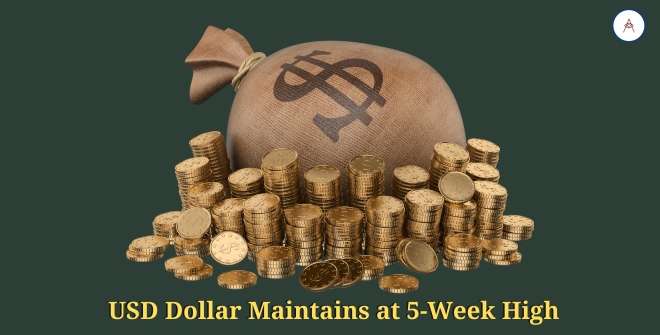USD Dollar Maintains at 5-Week High: Explore the factors influencing the currency’s stability and market trends in our latest blog post.
The US dollar (USD) held at five-week highs against significant competitors on Thursday,
after solid retail sales data in the United States powered hopes that the Federal Reserve will not rush to cut interest rates.
After hitting 103.69 on Wednesday for the first time since December 13, the U.S. dollar index, which evaluates the currency against a basket of six opponents, remained stable at 103.34 in Europe.
Trader expectations of the first Federal Reserve rate decrease by March have increased from 65% on Tuesday to 61%, per CME’s FedWatch tool.
Despite this week’s retreat by Fed officials, including as Governor Christopher Waller, against expectations of a dramatic easing of policy, the market is still pricing in roughly 145 basis points of cuts by year-end.
The data has been mixed, but yesterday we had a really solid retail sales report that demonstrates there is no need to be overly strict with rate reduction,” said Nils Christensen, Nordea’s chief analyst.
“Lower rate cut expectations and risk aversion are positive for the dollar,” the economist said.
Not since late November did the dollar appreciate to 148.525 yen on Wednesday.
At 147.895 yen last day, it was trading 0.2% lower. However, it was only worth 144.35 yen at the end of last week.
The Bank of Japan’s damaged bonds are still being priced by traders after a terrible earthquake struck central Japan on New Year’s Day.
Next week, Monday and Tuesday are the policy meetings scheduled by the BOJ.
According to Shuki Omori, head of Mizuho Securities’ Japan desk, “I think the dollar-yen is going to float between 145 and even 150 in the near term,” a level last saw in mid-November.

Early in February, the dollar might reach $150 if the BOJ maintains its dovish message and Fed Chair
Jerome Powell adopts a similar attitude to Waller at the U.S. central bank’s January 30-31 policy meeting. According to Omori, the yen might rise over that.
In an attempt to stop the yen’s depreciation, he continued, “The Japanese authorities could start coming in any time now and intervene verbally”.
After some indication of the timing of the first rate cut was provided by accounts from the European Central Bank’s December meeting, the euro saw minimal movement at $1.0880.
Following ECB President Christine Lagarde’s remarks to Bloomberg that ECB officials are open to lowering interest rates in the summer,
the single currency recovered on Wednesday from a five-week low of $1.08445. The majority will be in favor of later cutting the spring short of what the market expected.
After an increase on Wednesday, when statistics revealed that inflation unexpectedly increased in December,
the British pound remained flat at $1.2676, supporting predictions that the Bank of England would be more accommodating than its rivals. I will reduce the charges gradually.
With a 0.3% increase on Wednesday, the British pound reversed a three-day decline against the US dollar and limited Wednesday’s gains for the dollar index, of which currency is a part.
After dropping 0.4% to $0.65255 in December due to statistics indicating an unexpected drop in employment, the Australian dollar gained 0.2% to $0.6566, supporting the notion that rates are rising in the nation.
According to CitiIndex senior market analyst Matt Simpson, “There is some technical support around $0.6520 that would be difficult to short above.”
“Yet the jobs report provides no meaningful reason for a prolonged AUD,” the analyst stated.
“And that means its next directional move is in the hands of Fed expectations and therefore the US dollar.”
See also our recent post Apple iPhone 15 Receives Rare Discount



